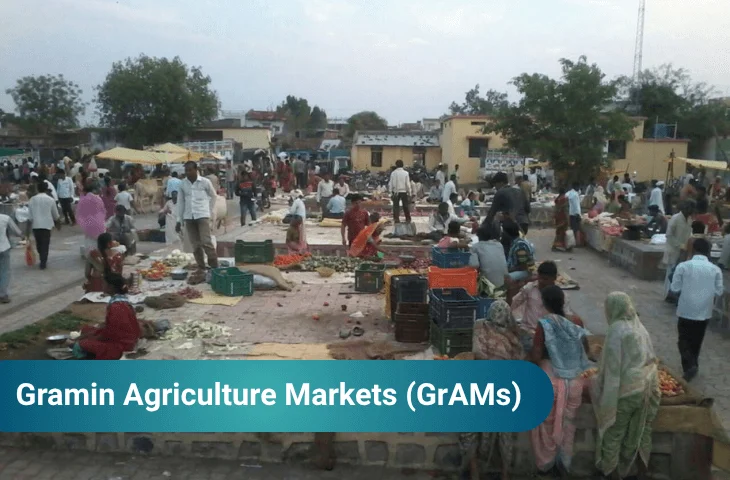Gramin Agriculture Markets, popularly known as GrAMs, are a government-led initiative aimed at transforming India’s traditional rural “haats” into modern, organized retail marketplaces. Launched in the Union Budget 2018-19, the program focuses on enhancing the infrastructure of rural markets to provide better access for small and marginal farmers.
These markets are designed not only to improve the local sale of agricultural produce but also to link rural farmers with larger national markets, including online platforms. By doing so, GrAMs aim to ensure that farmers receive fair prices while reducing dependency on middlemen.
Why were GrAMs Introduced?
India has a significant population of small and marginal farmers over 86% of all farmers fall under this category. Many of these farmers face challenges in selling their produce efficiently due to limited infrastructure, lack of storage facilities, and dependency on local traders. The main objectives behind introducing GrAMs include:
- Improving Market Access: Creating organized marketplaces close to rural communities.
- Better Price Realization: Enabling farmers to sell produce directly to consumers and traders.
- Reducing Post-Harvest Losses: Developing storage, weighing, and other marketing facilities.
- Connecting with Broader Markets: Linking local markets with e-NAM and wholesale APMC mandis.
How are GrAMs Implemented?
The program primarily focuses on transforming existing rural haats into GrAMs. The government has planned to upgrade approximately 22,000 haats across India, providing farmers with organized market spaces equipped with necessary infrastructure.
| Aspect | Details |
| Infrastructure Components | – Boundary walls and proper drainage systems – Marketing facilities such as storage sheds, weighing scales, and grading units – Electronic displays and digital platforms to showcase prices and availability |
| Purpose of Infrastructure | Ensures transparency, proper handling of produce, and improved customer engagement |
| Initial Funding Source | MGNREGS (Mahatma Gandhi National Rural Employment Guarantee Scheme) for basic infrastructure development |
| Primary Funding Source for Large-Scale Upgrades | Agri-Market Infrastructure Fund (AMIF) managed by NABARD with a corpus of Rs. 2,000 crore |
| Support Provided by AMIF | – Subsidized loans to states and Union Territories – Encourages innovative market models like hub-and-spoke systems – Supports Public-Private Partnership (PPP) mode projects |
What is the Role of AMIF in GrAMs Development?
The Agri-Market Infrastructure Fund (AMIF) was approved by the Cabinet Committee on Economic Affairs (CCEA) in 2019. The scheme aims to provide financial assistance to states for upgrading 10,000 GrAMs and 585 APMC markets.
- Subsidized Loans: States and UTs receive financial support to develop marketing infrastructure.
- Integration with e-NAM: Linking GrAMs with the National Agriculture Market (e-NAM) platform for transparent online trade.
- Innovative Market Models: Encouraging hub-and-spoke models and PPP-based integrated market projects.
- Interest Subsidy: NABARD provides interest subsidies aligned with the annual budget allocations.
Check Out: Complete List of Important Schemes for NABARD Grade A Exam
How do GrAMs Benefit Farmers?
GrAMs offer multiple advantages to rural farmers, particularly small and marginal landholders:
- Direct Sales to Consumers: Farmers can sell their produce locally without intermediaries.
- Aggregation of Produce: Markets serve as collection points to sell produce in bulk.
- Price Discovery and Fair Remuneration: Through linkages with e-NAM, farmers benefit from transparent pricing.
- Reduced Post-Harvest Losses: Availability of storage, weighing, and grading reduces wastage.
- Market Connectivity: GrAMs bridge the gap between local markets, APMCs, and larger electronic marketplaces.
How are GrAMs Linked with Technology and Digital Platforms?
A notable feature of GrAMs is their integration with e-NAM, the National Agriculture Market portal. This digital platform enables:
- Online trade of aggregated produce
- Transparent price discovery
- Access to terminal markets beyond the local region
Get ready to crack government job exams with leading educators
What Challenges do GrAMs Face?
Despite the clear benefits, the implementation of GrAMs has encountered several challenges:
- Slow Progress: Only a portion of the planned 22,000 haats have been upgraded so far.
- Demand-Driven Nature: Implementation relies on demand from states and UTs, which may vary.
- Regulatory Concerns: GrAMs operate in a relatively non-regulated environment, necessitating appropriate monitoring and management to avoid market inefficiencies.
- Infrastructure Maintenance: Ensuring upkeep of facilities over the long term remains a concern.
What is the Significance of GrAMs for India’s Agriculture Sector?
The significance of GrAMs can be understood in the context of India’s agricultural landscape:
- Support for Small Farmers: With the majority of farmers being small and marginal, GrAMs provide a platform to participate effectively in the market.
- Reduced Intermediaries: Direct access to consumers reduces reliance on middlemen, improving profitability.
- Better Storage Facilities: The creation of rural godowns enables farmers to store produce and avoid distress sales.
- Modernized Market Systems: Integration with e-NAM and modern infrastructure increases market efficiency.
- Boost to Rural Economy: By facilitating trade and market linkages, GrAMs contribute to overall rural economic growth.
How does NABARD Support GrAMs and AMIF?
The National Bank for Agriculture and Rural Development (NABARD) plays a pivotal role in the successful implementation of GrAMs and AMIF:
- Provides subsidized loans to states and UTs
- Monitors infrastructure development projects
- Ensures backward and forward linkages to strengthen rural markets
- Supports integrated development programs like watershed development and self-help group linkages
What are the Objectives of GrAMs and AMIF?
The primary objectives of GrAMs and AMIF include:
- Enhancing marketing infrastructure in rural areas and regulated APMC markets
- Linking GrAMs with digital platforms for transparent online trade
- Creating a better farmer-consumer interface
- Modernizing storage, processing, and ancillary facilities
- Promoting inter-mandi and inter-state trade through improved logistics
Also Check: List of Government Schemes of India
What is the Implementation Timeline of AMIF and GrAMs?
The Agri-Market Infrastructure Fund (AMIF) was announced in 2018-19 and will remain operational until 2025-26, with a moratorium period of two years.
The program initially targeted the development of 10,000 rural haats during 2018-19 and 2019-20, with future expansions planned based on demand and progress.
What are the Future Prospects of GrAMs?
The future of GrAMs lies in further integration of digital technologies, expansion of market linkages, and adoption of innovative market models. Key areas of focus include:
- Expanding e-NAM integration to all GrAMs
- Strengthening logistics and cold storage facilities
- Promoting public-private partnerships for sustainable development
- Encouraging states to implement hub-and-spoke models for efficient aggregation and distribution
Key Takeaways
| Aspect | Details |
| Program | Gramin Agriculture Markets (GrAMs) |
| Launched | 2018-19 Union Budget |
| Objective | Upgrade rural haats, improve farmer market access, reduce post-harvest losses |
| Infrastructure | Storage, weighing, grading, drainage, boundary walls, digital displays |
| Funding | MGNREGS (initial), AMIF (NABARD corpus Rs. 2000 crore) |
| Number of Markets | 22,000 haats targeted, 10,000 covered under AMIF initially |
| Integration | e-NAM, APMC mandis, hub-and-spoke models |
| Benefits | Direct sales, aggregation, price discovery, better storage, farmer-consumer interface |
| Implementation | Demand-driven, states/UTs utilize AMIF, PPP and innovative models encouraged |
| Operational Period | 2018-19 to 2025-26 |
Questions Based on Gramin Agriculture Markets (GrAMs)
- What is the main objective of Gramin Agriculture Markets (GrAMs)?
- A) Improve urban markets
- B) Upgrade rural haats and improve farmer access
- C) Subsidize fertilizers
- D) Promote industrial growth
- E) Reduce import of food grains
- How many rural haats are planned to be upgraded under GrAMs?
- A) 5,000
- B) 10,000
- C) 15,000
- D) 22,000
- E) 30,000
- Which fund supports the large-scale infrastructure development of GrAMs?
- A) MGNREGS
- B) PMFBY
- C) AMIF
- D) SFAC
- E) NMSA
- What is the role of NABARD in GrAMs?
- A) Monitor foreign trade
- B) Provide subsidized loans and technical support
- C) Set MSP for crops
- D) Regulate APMC markets directly
- E) Provide insurance to farmers
- How are GrAMs linked to digital platforms?
- A) Through online banking
- B) Through e-NAM
- C) Through social media marketing
- D) Through mobile recharge points
- E) Through digital payment only
- Which scheme initially funded GrAMs before AMIF?
- A) PM-Kisan
- B) MGNREGS
- C) APY
- D) PMFBY
- E) NREGA
- What is a major benefit of GrAMs for small farmers?
- A) Reduced crop yield
- B) Direct access to consumers
- C) Increased taxation
- D) High labor costs
- E) Dependency on intermediaries
- How does AMIF support states in developing GrAMs?
- A) Provides grants for free
- B) Provides subsidized loans and encourages innovative projects
- C) Offers crop insurance
- D) Provides training to farmers only
- E) Sets up new haats independently
- What percentage of Indian farmers are small and marginal?
- A) 50%
- B) 65%
- C) 86%
- D) 75%
- E) 90%
- What is the operational period of AMIF?
- A) 2015-20
- B) 2016-22
- C) 2018-19 to 2025-26
- D) 2019-25
- E) 2020-27
Also Read:
Answer Key
| Question No. | Correct Answer | Question No. | Correct Answer |
| 1 | B | 6 | B |
| 2 | D | 7 | B |
| 3 | C | 8 | B |
| 4 | B | 9 | C |
| 5 | B | 10 | C |
- MISHTI Scheme, India’s Initiative to Restore Mangrove Ecosystems
- National Green Hydrogen Mission Features, Objectives, and Benefits
- Paramparagat Krishi Vikas Yojana, Transforming India’s Organic Farming
- Mission on Integrated Development of Horticulture NHM and HMNEH
- Swachh Bharat Mission, India’s Journey Towards Cleanliness and Hygiene
- SAGY, A Step Towards Holistic Development of Indian Villages

Hi, I’m Aditi. I work as a Content Writer at Oliveboard, where I have been simplifying exam-related content for the past 4 years. I create clear and easy-to-understand guides for JAIIB, CAIIB, and UGC exams. My work includes breaking down notifications, admit cards, and exam updates, as well as preparing study plans and subject-wise strategies.
My goal is to support working professionals in managing their exam preparation alongside a full-time job and to help them achieve career growth.
